Nucleus and Nation
Scientists, International Networks, and Power in India
In 1974 India joined the elite roster of nuclear world powers when it exploded its first nuclear bomb. But the technological progress that facilitated that feat was set in motion many decades before, as India sought both independence from the British and respect from the larger world. Over the course of the twentieth century, India metamorphosed from a marginal place to a serious hub of technological and scientific innovation. It is this tale of transformation that Robert S. Anderson recounts in Nucleus and Nation.
Tracing the long institutional and individual preparations for India’s first nuclear test and its consequences, Anderson begins with the careers of India’s renowned scientists—Meghnad Saha, Shanti Bhatnagar, Homi Bhabha, and their patron Jawaharlal Nehru—in the first half of the twentieth century before focusing on the evolution of the large and complex scientific community—especially Vikram Sarabhi—in the later part of the era. By contextualizing Indian debates over nuclear power within the larger conversation about modernization and industrialization, Anderson hones in on the thorny issue of the integration of science into the framework and self-reliant ideals of Indian nationalism. In this way, Nucleus and Nation is more than a history of nuclear science and engineering and the Indian Atomic Energy Commission; it is a unique perspective on the history of Indian nationhood and the politics of its scientific community.
736 pages | 16 halftones, 1 map, 9 tables | 6 x 9 | © 2010
Geography: Cultural and Historical Geography
History: Asian History, History of Technology
Reviews
Table of Contents
Preface
Acknowledgments
Note on Spelling, Photographs, and Currencies
Map of Atomic Energy, Space, and Defense Research Centers
Atomic Energy and Space Research Establishments in 1974
one Introduction
two Building Scientific Careers in the 1920s: Saha and Bhatnagar, from London to Allahabad and Lahore
three The Bangalore Affair, 1935–38: Scientists and Conflict around C. V. Raman
four Imagining a Scientific State: Nehru, Scientists, and Political Planning, 1938–42
five Homi Bhabha Confronts Science in India, 1939–44
six Indian Scientists Engage the Empire: The CSIR and the Idea of Atomic and Industrial Power
seven Saha, Bhatnagar, and Bhabha in Contrast, 1944–45
eight Restless in Calcutta: Meghnad Saha’s Institution-Building
nine Bhatnagar Builds His Chain of Laboratories and Steps Upward
ten Bhabha Builds His Institute in Bombay
eleven The Politics of the Early Indian Atomic Energy Committee and Commission
twelve Scientific Networks, Nehru, and Defense Research and Development
thirteen A Scientist in the Political System: Professor Saha Goes to Parliament, 1952–55
fourteen The Cabinet and Scientific Advice in the 1950s and 1960s: Bhabha, Atomic Energy, and Scientific and Industrial Research
fifteen A New Scientific Elite: Sarabhai Builds Another Atomic Energy Network, 1966–71
sixteen A Day in the Life of Two Research Institutes in Bombay and Calcutta
seventeen Governance, Management, and Working Conditions in Research Institutes Founded by Saha and Bhabha
eighteen Governance and Influence in the Research Institutes Bhatnagar Built
nineteen Articulating Science and Technology Policy for Indira Gandhi’s Cabinet
twenty Building a High-Technology Economy through Atomic Energy, Space, and Electronics
twenty-one Nuclear Expectations and Resistance in India’s Political Economy
twenty-two Scientists in India’s War over Self-Reliance
twenty-three The First Bomb Test: Its Context, Reception, and Consequences in India
twenty-four The Scientific Community, the State of Emergency, and After, 1975–80
twenty-five Conclusions
Chronology of Events
Biographical Notes
Notes
Index
